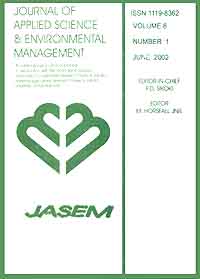
|
Journal of Applied Sciences and Environmental Management
World Bank assisted National Agricultural Research Project (NARP) - University of Port Harcourt
ISSN: 1119-8362
Vol. 9, No. 2, 2005, pp. 65-72
|
 Bioline Code: ja05047
Bioline Code: ja05047
Full paper language: English
Document type: Research Article
Document available free of charge
|
|
|
Journal of Applied Sciences and Environmental Management, Vol. 9, No. 2, 2005, pp. 65-72
| en |
Effect of Processing Techniques on The Contents of Flatulence Factors and Emulsion Properties of Cowpea ( Vigna unguiculata  ) )
ONYESOM, I; ENAHOLO, AT;MORDI, J
Abstract
The effect of some processing techniques (germination boiling and dehulling) on the soluble sugar contents and the emulsion property of processed flour were studied. Results show that germination significantly reduced the raffinose level from the third to the fifth day sprouting period (P<0.05). Boiling and dehulling also reduced the content of this flatus oligosaccharide (raffinose) but not to a significant proportion (P>0.05). The contents of other soluble sugars-galactose, glucose and sucrose were increased by germination (P<0.05) and boiling (P>0.05) but reduced by dehulling (P>0.05). Germination, dehulling and boiling lowered the emulsion stability property of cowpea flour. Even though, it is not conventional to either malt or dehull cowpea seeds before cooking, individuals should be advised to do so, in order to minimize the flatus potential and the accompanied discomfort associated with beans consumption. However, such processing techniques would not be appropriate for foods that need good emulsion. @JASEM.
|
| |
© Copyright 2005 - Journal of Applied Sciences & Environmental Management
|
|
